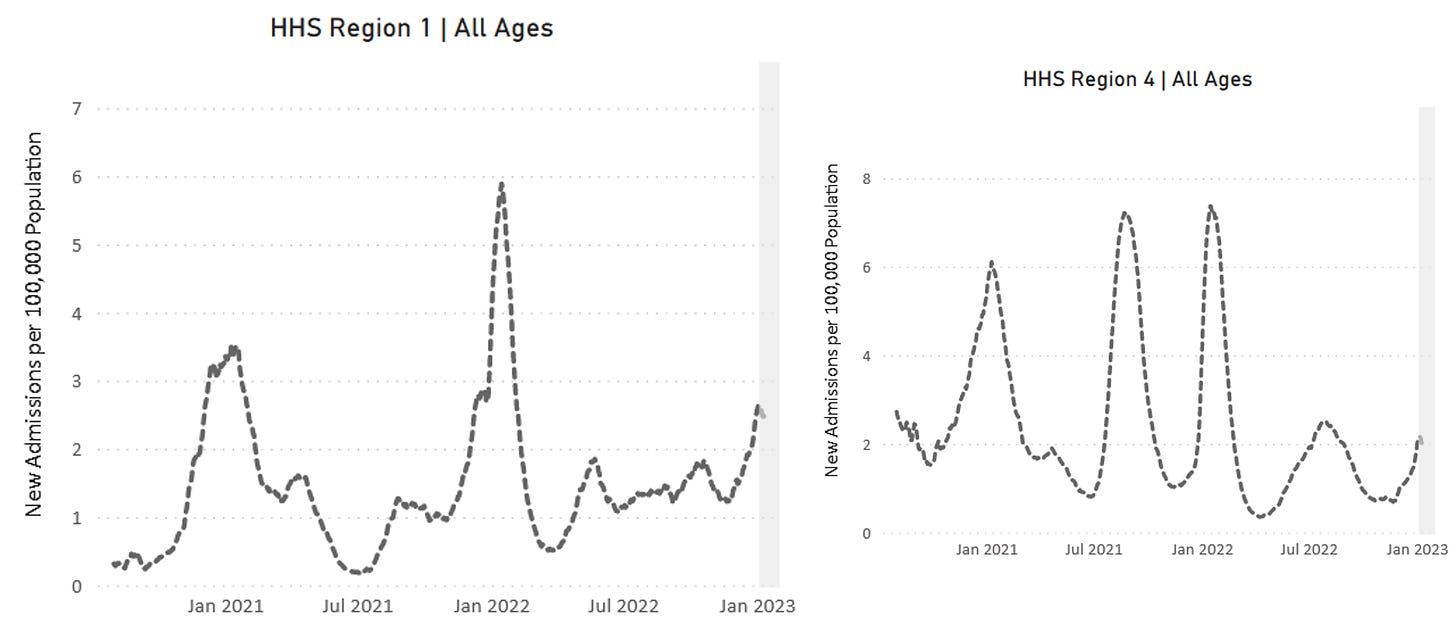The Weather: Transmission levels remain high, with 95.8 percent of the population living in areas with substantial or higher transmission. Rates are particularly high along with the East Coast, with lower levels in the West.
On Variants: This week the new variant XBB 1.5 (Kraken) is now almost tied with BQ1/1.1 for most common variant (43% vs 44.7%), and is expected to surpass it next week. It continues to dominate in the Northeast though it is quickly spreading throughout the U.S.

This rapid growth is very worrying. According to the World Health Organization, Kraken is the most transmissible COVID variant to date.
This high transmissibility is due to how Kraken appears to combine the extreme immune evasion of XBB with the strong binding affinity to cells of B 2.75, making it likely to be a dominant and pathological variant.
Regional differences in dominant variants remain, though the gap is closing as the weeks go on. Kraken (dark purple) is dominant in the Northeast and almost dominant in the Southeast, with the rest of the US still dominated by BQ1/1.1 (teal green).

Wastewater Monitoring: National wastewater levels have dropped a bit, though they remain higher than any winter peak prior to Omicron.

Wastewater levels continue to be highest in the Northeast, and wastewater in all regions appear to be on the decline.

Hospitalizations: While hospitalizations are starting to take a small dip, they are still so high that they rival the Delta wave peak for those over 70.

Hospitalizations have shown a slight decline in the Northeast (for example Region 1) and the South (Region 4) although it is too early to tell whether the decline will continue or if hospitalizations will rise again soon.

Deaths: The week of January 11, at least 3,907 people died of COVID nationally, an alarmingly high 44% increase compared to the previous week. This is only the second time deaths have been this high since the original omicron wave in the beginning of 2022.

Long COVID: At least 65 million people throughout the world have Long COVID, a post-COVID condition with over 200 potential symptoms impacting multiple organ systems and the ability to weaken the immune system through T cell exhaustion.
Long COVID is already being supplanted by “Longer COVID” as new figures from the Office of National Statistics (ONS) show that 30% of Long COVID sufferers have experienced symptoms for more than two years now.
The best way to prevent Long COVID is to not catch COVID in the first place. Continue to use all layers of protection available, including wearing a high-filtration mask, getting your bivalent booster, and purifying the air indoors.
Forecast: It is clear that we need as many people boosted as possible to reduce transmission and bring us closer to the end of the pandemic. Unfortunately, only 16% of individuals in the US have taken the bivalent booster dose.
This underscores the need for us as a society to systematically address vaccine inequity.
One ray of hope in this dire time is that a new at-home test-to-treat program is being piloted by the NIH for people to get COVID treatment and testing from the safety of their living rooms.
This is a virtual community health program providing free COVID services including tests, telehealth sessions, and treatments at home. It is starting at Berks County, Pennsylvania and will be available for up to 8,000 eligible residents.
Program organizers are using this as an opportunity to learn and expand the program to the entire country in the foreseeable future. One can even imagine such a program eventually incorporating cutting-edge COVID treatments.
Even now, a monoclonal antibody cal\led Actemra has already just been approved in the past couple months for hospitalized COVID patients. And more antibody treatments are currently being developed.
Invivyd is developing an omicron-proof antibody therapy with clinical trials starting this year. Atea is designing an experimental COVID pill that will be ready for clinical trials in early 2024, which is expected to be harder for viruses to resist.
Take Action: We envision a future where our freedom to live healthy lives is protected, and welcome you to join us in working to make that future a reality. Please join us at our upcoming webinar on Thursday to learn more about the People’s CDC and help us take action.
To help those who catch COVID, we have put together What to Do if You Have COVID, a comprehensive guide on what you should do to best protect your long term health and the health of others in your community. Please take a look and share it far and wide.
We ask that you join us in writing to our elected officials to demand that they build a robust public health infrastructure to protect us and our loved ones during the ongoing pandemic, rather than ration away our healthcare and leave us to suffer.
Notes: 1) The numbers in this report were current as of 1/13/23. The CDC updates data frequently as it receives refreshed information. Today’s numbers may be slightly different from the data here. 2) Check out the links throughout & see our website for more! https://peoplescdc.org.


